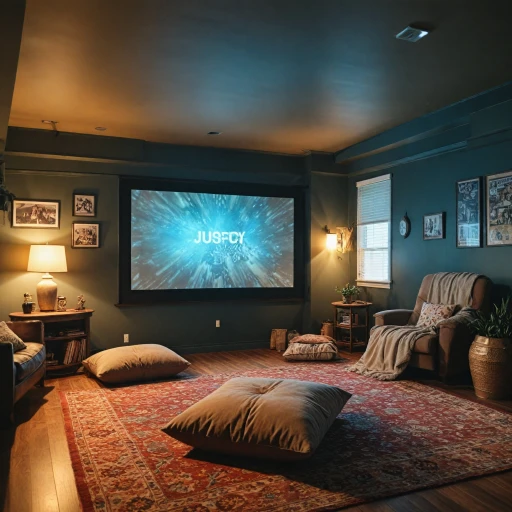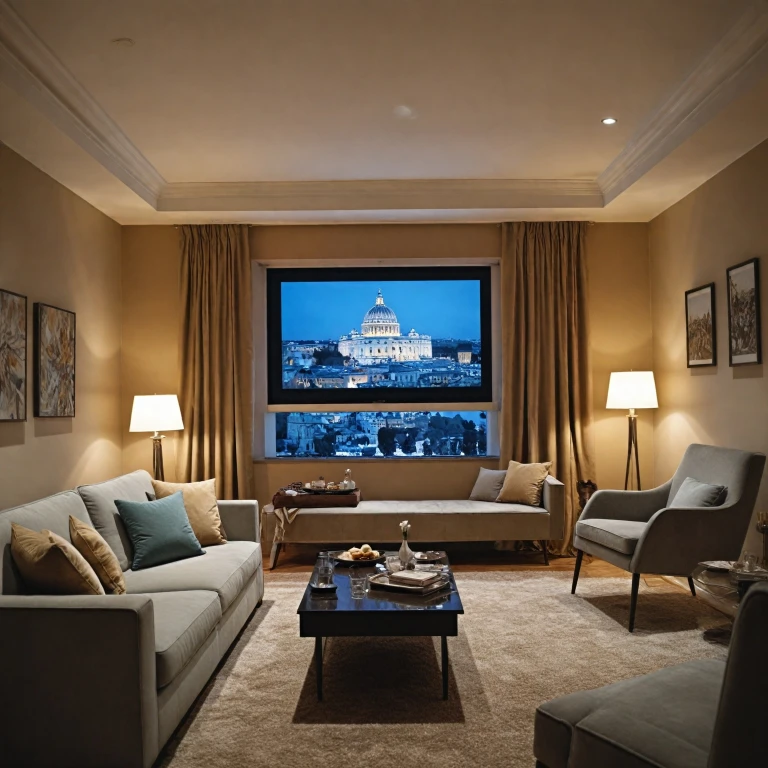Understanding Rising Projector Screens
A Look into the Convenience of Rising Projector Screens
Understanding the concept of rising projector screens offers a smart solution for those who seek convenience without sacrificing quality. Unlike traditional permanent installations, these screens are designed to emerge from a floor casing, providing a clean and modern aesthetic.
Rising screens, sometimes referred to as motorized floor screens, integrate technology smoothly into your living space. They emerge at a press of a button, allowing for a seamless transition from a regular room to an impressive home theater setup.
Floor rising screens such as those produced by Elite Screens or Vividstorm offer flexible solutions for various projector types, including ultra short and short throw projectors. They can even handle ambient light rejection (ALR) needs, ensuring a vivid projection even in bright conditions.
Furthermore, rising projector screens come in a range of sizes, from compact 80-inch models to more expansive options, fitting both budget and room constraints. These screens often feature high-quality materials such as matte white or specialized ALR screens, enhancing the projection quality.
To read more about enhancing your home theater setup with floor screens and understand their unique advantages, check out this
detailed article.
Benefits of a Rising Projector Screen
Advantages of Choosing a Rising Projector Screen
Investing in a rising projector screen can truly elevate the viewing experience in your home theater setup. These screens offer several key benefits that cater to both aesthetic and functional needs. Here's why a rising screen might be the right choice for your space.
- Sleek and Space-Saving Design: A rising screen seamlessly integrates into your living space, often retracting into a discreet floor case or housing when not in use. This provides a clean look and allows for flexible room arrangements.
- Enhanced Image Quality: Many rising screens are equipped with Ambient Light Rejection (ALR) technology, which is designed to maintain image clarity and brightness even under challenging lighting conditions. ALR screens are perfect for environments where controlling ambient light is difficult, ensuring a crisp picture that rivals even the best televisions.
- Versatility in Application: Suitable for a variety of projector types, including short throw and ultra-short throw projectors, rising screens can achieve optimal projection without taking up significant floor space. This is particularly advantageous in small or uniquely shaped rooms.
- Motorized Operation: Convenience is key, and many rising screens are motorized for effortless use. The ability to operate the screen via remote control adds to the overall ease, making the switch between use and storage practically seamless.
- High-Quality Materials: Opting for a screen made from quality materials like matte white surfaces or elite grade fabric ensures durability and superior performance. Brands such as Vividstorm and Elite Screens offer rising screens with reliable build quality at various price points.
Ultimately, whether you opt for a motorized floor rising setup or invest in a premium ALR projector screen, the aim is to enhance your home cinema experience effectively. By considering these benefits, you can make an informed decision that suits your preferences and environment.
Installation Considerations
Installation Aspects to Consider
When it comes to installing a rising projector screen, there are several key factors to consider to ensure a smooth setup and optimal viewing experience.
- Space and Location: Determine the ideal location in your home theater for the rising screen. Consider the available floor space and ensure there's enough room for the screen to extend without obstruction. Short throw and ultra short throw projectors can be beneficial in smaller spaces, allowing the screen to be closer to the projector.
- Screen Types and Size: Decide on the type of screen suitable for your projector setup. Options range from ALR screens that enhance image quality in spaces with ambient light, to matte white varieties that offer a versatile solution. Brands like Elite Screens and Vividstorm provide a variety of screens in different sizes, commonly up to 100 inches or more, so consider the dimensions that best fit your room.
- Motorized Functionality: The inclusion of motorized floor rising features simplifies the process of extending and retracting the screen. The quality of the motor can influence both the functionality and the price, with premium options like those from elite brands offering smoother operation.
- Professional Installation vs. DIY: Evaluate whether you will handle the installation yourself or require professional assistance. While DIY can save on costs, a professional can ensure that the projector and screen are optimally aligned, providing the best possible viewing experience.
For a seamless viewing experience and to complement your rising projector screen setup, consider enhancing your home theater with a
bluetooth surround sound system to achieve high-quality audio. This additional feature ties in beautifully with your new visual setup, ensuring an immersive overall experience.
Choosing the Right Screen Material
Selecting the Optimum Screen Material
When choosing a screen material for your rising projector screen, several factors come into play to ensure an enhanced viewing experience. Selecting the right material can significantly impact the picture quality and viewing comfort.
- Ambient Light Rejection (ALR) Screens: If you're dealing with ambient light in your viewing area, an ALR projector screen can be a lifesaver. These screens are designed to reject ambient light from the environment while enhancing the brightness and contrast from your projector, especially useful for ultra short throw (UST) projectors.
- Matte White Screens: Matte white screens offer a versatile and budget-friendly option. They provide nice color balance and sharpness, making them suitable for both traditional and rising screens. These are great if your room lighting is controlled.
- Price and Quality: The price range of screen materials can vary widely, with premium options like Vividstorm and Elite Screens offering high quality finishes. These screens often include motorized mechanisms for added convenience and are crafted to improve the overall projection experience.
- Screen Size and Throw Ratios: Consider the size of the screen in relation to your projector's throw ratio. Short throw projectors require a specific type of screen material to achieve the best results. Testing different materials for your setup can help achieve the optimal projection across a range from standard to 200-inch projector screens.
Choosing the right screen means balancing these factors to align with your setup and room conditions. A sound investment into a high-quality screen not only enriches the viewing experience but can also enhance the longevity and performance of the projector itself.
Maintenance and Care Tips
Maintaining Your Rising Projector Screen
When it comes to sustaining the longevity and optimal performance of your rising projector screen, a few care routines can make a substantial difference. Regular maintenance ensures that your screen continues to provide a quality viewing experience.
- Cleaning the Screen Surface: To keep the screen pristine, gently clean the matte white surface using a soft, lint-free cloth. For tougher stains or dust accumulation, consider a mild soap solution. Avoid harsh chemicals that may damage the material.
- Handling Motorized Components: Rising screens often come with motorized mechanisms. It’s essential to ensure these components, like the motor and lift system, are kept free from obstructions. Regularly check for any debris that might interfere with its operation.
- Avoiding Direct Sunlight: To maintain the color integrity and avoid unnecessary wear, position your screen away from direct sunlight. This is especially relevant for ALR screens, which are sensitive to ambient light conditions.
- Monitor Ambient Light Levels: Some projector screens, like ALR rising models, are designed to minimize the impact of ambient light. Ensure your setup optimizes this feature by controlling the room's lighting conditions during use.
- Routine Inspections: Regularly inspect the screen for any signs of wear and tear. Addressing minor issues promptly, such as a loosening motorized floor mechanism, can prevent major fixes later.
A well-maintained rising projector screen not only elevates your home theater experience but also safeguards your investment. Staying proactive with care ensures that each movie night or sporting event is displayed with elite quality and vivid visuals, regardless of whether you are using short or ultra short throw projectors. By following these simple care tips, you'll extend the life of your projector screens and continue to enjoy immersive viewing experiences for years to come.
Comparing Rising Screens to Traditional Screens
Comparative Insights: Rising Screens vs Traditional Screens
When deliberating between rising screens and their traditional counterparts, several factors come into play. Understanding these distinct differences helps ensure that you choose the best fit for your home theater setup.
- Installation Flexibility: Rising screens, especially those motorized and mounted from the floor, provide flexibility in installation that traditional screens simply can't match. Being able to integrate a screen that ascends from the floor means you can maintain an uncluttered look while being functionally versatile.
- Space-Saving Design: Unlike fixed screens, rising screens can be stowed away when not in use. This is particularly beneficial in rooms where space is a premium or in multipurpose areas such as living rooms.
- Performance Under Different Lighting Conditions: Many rising screens are equipped with ALR (Ambient Light Rejecting) technology, which makes them suitable even in rooms with significant ambient light. Meanwhile, traditional matte white screens might struggle in similar conditions, albeit at a potentially lower price point compared to rising ALR-equipped models.
- Customization Options: The market offers a range of advanced features with rising projector screens, such as ultra short throw compatibility and motorized floor-rising mechanics, exemplified by brands like Vividstorm and Elite Screens. These features allow for a more tailored experience versus the standard off-the-wall options typical of fixed screens.
- Cost Considerations: It’s worth noting that while rising screens offer many advantages, they tend to come at a higher price. For instance, a motorized floor screen from high-end brands like Elite Screens or Awol Vision may be costlier than traditional fixed screens due to their advanced functionalities. However, the investment can pay off in terms of the viewing experience and convenience.
Choosing the appropriate projector screen hinges on the balance between space availability, budget, and specific aesthetic and performance needs. Whether selecting a fixed screen or a rising screen, understanding these technological distinctions ensures that your home cinema setup will deliver an exceptional viewer experience.

